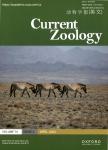Bigger or long-winged male common crossbills exhibit redder carotenoid-based plumage coloration
作者机构:Biologia AmbientalUniversidad de NavarraFacultad de CienciasC/Irunlarrea1 Pamplona31008 NavarraSpain OrnitologiaSociedad de Ciencias de AranzadiZorroagagaina 1120014 DonostiaSan SebastianSpain Ecologia EvolutivaMuseo Nacional de Ciencias Naturales(CSiC)Edificio Pinar 2528006 MadridSpain
出 版 物:《Current Zoology》 (动物学报(英文版))
年 卷 期:2023年第69卷第2期
页 面:165-172页
核心收录:
学科分类:0710[理学-生物学] 07[理学] 071002[理学-动物学]
基 金:The study is part of the project PID2019-109303GB-I00 funded by MCIN/AEI/10.13039/501100011033.
主 题:avian carotenoids color and biometrics Loxia genus Mediterranean crossbills resource allocation trade-offs shared pathway hypothesis
摘 要:Carotenoid-based ornaments are often considered reliable(honest)individual condition signals because their expression implies physiological costs unaffordable for low-quality animals(handicap signals).Recently,it has been suggested that efficient cell respiration is mandatory for producing red ketocarotenoids from dietary yellow carotenoids.This implies that red colorations should be entirely unfalsifiable and independent of expression costs(index signals).In a precedent study,male common crossbills,Loxia curvirostra,showing a red plumage reported higher apparent survival than those showing yellowish-orange colors.The plumage redness in this species is due to ketocarotenoid accumulation in feathers.Here,we correlated the male plumage redness(a 4-level visual score:yellow,patchy,orange,and red)and the body morphology in more than 1,ooo adult crossbills captured in 3 Iberian localities to infer the mechanisms responsible for color evolution.A principal component analysis summarized morphometry of 10 variables(beak,wing,tarsus length,etc.).The overall body size(PC1)and the length of flight feathers regarding body size(Pc3)showed significant positive relationships with plumage redness.Plumage redness was barely correlated with bill shape measures,suggesting no constraint in acquiring carotenoids from pine cones.However,large body sizes or proportionally long flying feathers could help carotenoid acquisition via social competition or increased foraging ranges.Proportionally longer flight feathers might also be associated with a specific cell respiration profile that would simultaneously favor flying capacities and enzymatic transformations needed for ketocarotenoid synthesis.Such a phenotypic profile would agree with the hypothesis of ketocarotenoid-based colors acting as individual quality index signals.



